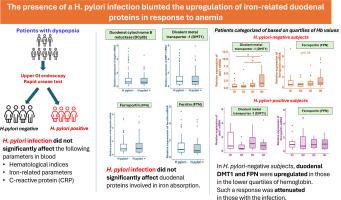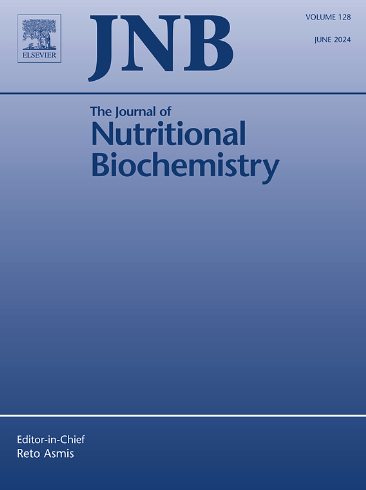幽门螺杆菌感染的存在减弱了铁相关十二指肠蛋白在贫血反应中的上调。
IF 4.9
2区 医学
Q1 BIOCHEMISTRY & MOLECULAR BIOLOGY
引用次数: 0
摘要
背景与目的:幽门螺杆菌感染常与缺铁性贫血有关。这种关联背后的机制尚不清楚。我们试图确定是否存在幽门螺杆菌感染影响铁稳态。方法:接受上消化道内窥镜检查的消化不良患者分为未感染幽门螺杆菌和感染幽门螺杆菌两组。血液样本中的血液学和铁相关参数及c反应蛋白(CRP)被评估。测定十二指肠粘膜样品中参与铁吸收的蛋白(二价金属转运蛋白1 [DMT1]、十二指肠细胞色素B还原酶[DCYTB]、铁蛋白[FTN]和铁转运蛋白[FPN])的基因表达。结果:未感染幽门螺杆菌组与感染幽门螺杆菌组血液血液学及铁相关指标、血CRP水平、十二指肠铁相关蛋白基因表达差异无统计学意义。当根据血红蛋白值分层为四分位数时,低四分位数的患者(两组)都显示出较低的铁状态。十二指肠DMT1和FPN基因表达上调是对贫血(一种已知的生理现象)的反应,在未感染的患者中发现,但在感染的患者中没有发现。DYCTB在幽门螺杆菌感染者中表达显著降低,表达幽门螺杆菌相关毒力因子CagA和VacA。结论:幽门螺旋杆菌感染对血液学指标、血液铁状态标志物及十二指肠铁吸收相关蛋白基因表达无显著影响。然而,DMT1和FPN基因表达上调对贫血的生理反应在感染后减弱。本文章由计算机程序翻译,如有差异,请以英文原文为准。

The presence of a H. pylori infection blunted the upregulation of iron-related duodenal proteins in response to anemia
Helicobacter pylori (H. pylori) infection is often associated with iron-deficiency anemia. The mechanisms that underlie this association are unclear. We attempted to determine whether the presence of a H. pylori infection affected iron homeostasis. Patients with dyspepsia, who underwent an upper gastrointestinal endoscopy, were categorized into those without and with a H. pylori infection. Hematological and iron-related parameters and C-reactive protein (CRP) were estimated in their blood samples. Gene expression of proteins involved in iron absorption (divalent metal transporter 1 [DMT1], duodenal cytochrome B reductase [DCYTB], ferritin [FTN] and ferroportin [FPN]) was determined in duodenal mucosal samples. Hematological and iron-related parameters and CRP levels in blood, and gene expression of duodenal iron-related proteins were not significantly different in those without and with a H. pylori infection. When stratified into quartiles based on hemoglobin values, patients in the lower quartiles (in both groups) showed evidence of a lower iron status. Upregulation of duodenal DMT1 and FPN gene expression in response to anemia (a known physiological phenomenon) was seen in uninfected patients, but not in those with the infection. DYCTB expression was significantly lower in those with the infection, who expressed H. pylori-associated virulence factors, CagA and VacA. H. pylori infection did not significantly affect hematological parameters, blood markers of iron status and gene expression of duodenal proteins involved in iron absorption. However, the physiological response to upregulate DMT1 and FPN gene expression in response to anemia was attenuated in those with the infection.
求助全文
通过发布文献求助,成功后即可免费获取论文全文。
去求助
来源期刊

Journal of Nutritional Biochemistry
医学-生化与分子生物学
CiteScore
9.50
自引率
3.60%
发文量
237
审稿时长
68 days
期刊介绍:
Devoted to advancements in nutritional sciences, The Journal of Nutritional Biochemistry presents experimental nutrition research as it relates to: biochemistry, molecular biology, toxicology, or physiology.
Rigorous reviews by an international editorial board of distinguished scientists ensure publication of the most current and key research being conducted in nutrition at the cellular, animal and human level. In addition to its monthly features of critical reviews and research articles, The Journal of Nutritional Biochemistry also periodically publishes emerging issues, experimental methods, and other types of articles.
 求助内容:
求助内容: 应助结果提醒方式:
应助结果提醒方式:


